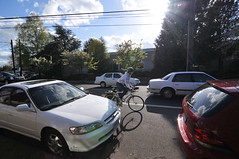The issue of new apartments being built in close-in neighborhoods without (or with very little) auto parking has been making headlines in Portland recently. I’m glad to see this story getting the attention it deserves. Portland has a parking problem and the first step to fixing it is awareness that it exists.
In short, developers throughout the central and north eastside have taken advantage of Portland city code that encourages the construction of apartment complexes without any obligation to include auto parking. The thinking was/is that if an apartment building is in a transit/biking/walking-friendly area, the lack of parking wouldn’t be a problem and it would actually encourage more people to go carfree (or low-car). Developers — eager to be seen as “eco-friendly” and save lots of money by not including expensive auto parking — jumped on the opportunity.
Many sustainable transportation advocates probably see that as a good thing, as limiting car use is a necessity for a city to function at its highest potential. That is indeed true; but the problem is we’re just not there yet.
Advertisement
Despite Portland planners’ dreams, most people still own cars and they need a place to put them. With increasing density (thanks to these apartment buildings), this means people are parking their cars on neighborhood surface streets. This increased demand on neighborhood parking has a lot of real consequences — many of which have come up in bike-related projects.
When activists wanted to try out Portland’s first “parklet” (what PBOT is now calling “street seats”), they were looking at N. Mississippi Avenue as a potential location. But when the idea floated around the neighborhood, there was opposition from some people on the grounds that there was already too much parking pressure on local surface streets.
When PBOT approached a project to improve the bikeway on N. Williams, in one busy area (near N. Failing Ave), the idea of removing parking to create more space for a protected bikeway was off the table before the public process even began. (PBOT’s calculation was that businesses would revolt against the idea.)
The spillover of auto parking on streets near busy commercial corridors also impacts how neighborhood greenways function. The increased traffic, looking for parking space, adds to the volume of cars and makes the side streets less pleasant to ride on. Another issue is when cars are parked right up to the corner, which limits sight lines and can make crossing by foot, bike or car more stressful and sometimes dangerous.
I’m all for developers building in fewer auto parking spots; but we need to be realistic. It seems to me the answer isn’t to roll-back the regulations and require more auto parking. Instead, in the short-term, we need to come up with more creative solutions to storing cars. More importantly, we need to make our planning dreams a reality by making decisions that will allow biking, walking and transit to compete with auto use. If more people felt biking was safe and convenient, and if they had more robust and reliable transit service nearby, we would see a much faster adoption of the carfree and low-car lifestyle I believe city planners hope for.
Put another way, Portland city code aspires to a city that doesn’t quite exist yet… So let’s hurry up and make that city a reality and the parking problem just might solve itself.
— Jonathan Maus: (503) 706-8804, @jonathan_maus on Twitter and jonathan@bikeportland.org
Get this post delivered directly to your inbox.
BikePortland needs your support.


